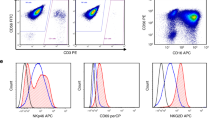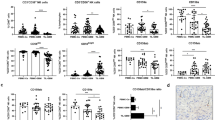Abstract
Natural killer (NK) cells are implicated in the surveillance of hematological malignancies. They participate in the immune response against residual acute myeloid leukemia (AML) after hematopoietic stem cell transplantation with partial HLA class I disparity. However, the role of NK cells in autologous leukemia-specific immunity remains poorly understood. We studied the function of NK cells in AML patients at diagnosis. Following isolation, CD56+CD3− cells exhibited a high proliferative potential in vitro in response to interleukin (IL)-2. The polyclonal population of activated AML-NK cells expressed normal levels of the activating receptor NKG2D and the major natural cytotoxicity receptor NKp46. AML-NK cells were highly effective with respect to interferon-γ production, cytotoxicity against HLA class I-deficient K562 erythroleukemia cells in vitro and retardation of tumor growth in vivo in K562-bearing NOD/SCID mice. Importantly, when AML blasts were injected into NOD/SCID mice, a single dose of adoptively transfered autologous AML-NK cells significantly reduced the AML load by 8–77%. Recognition of AML blasts may be related to the observed upregulation of ligands for NKG2D and natural cytotoxicity receptors in vivo. We conclude that AML patient-derived NK cells are fully functional, in support of exploring the benefit of AML immunotherapy with IL-2-stimulated autologous NK cells.
This is a preview of subscription content, access via your institution
Access options
Subscribe to this journal
Receive 12 print issues and online access
$259.00 per year
only $21.58 per issue
Buy this article
- Purchase on Springer Link
- Instant access to full article PDF
Prices may be subject to local taxes which are calculated during checkout






Similar content being viewed by others
References
Trinchieri G . Biology of natural killer cells. Adv Immunol 1989; 47: 187–376.
Cooper MA, Fehniger TA, Caligiuri MA . The biology of human natural killer-cell subsets. Trends Immunol 2001; 22: 633–640.
Moretta A, Bottino C, Vitale M, Pende D, Cantoni C, Mingari MC et al. Activating receptors and coreceptors involved in human natural killer cell-mediated cytolysis. Annu Rev Immunol 2001; 19: 197–223.
Bauer S, Groh V, Wu J, Steinle A, Phillips JH, Lanier LL et al. Activation of NK cells and T cells by NKG2D, a receptor for stress-inducible MICA. Science 1999; 285: 727–729.
Cosman D, Mullberg J, Sutherland CL, Chin W, Armitage R, Fanslow W et al. ULBPs, novel MHC class I-related molecules, bind to CMV glycoprotein UL16 and stimulate NK cytotoxicity through the NKG2D receptor. Immunity 2001; 14: 123–133.
Long EO . Regulation of immune responses through inhibitory receptors. Annu Rev Immunol 1999; 17: 875–904.
Vivier E, Nunes JA, Vely F . Natural killer cell signaling pathways. Science 2004; 306: 1517–1519.
Bottino C, Moretta L, Pende D, Vitale M, Moretta A . Learning how to discriminate between friends and enemies, a lesson from natural killer cells. Mol Immunol 2004; 41: 569–575.
Smyth MJ, Hayakawa Y, Takeda K, Yagita H . New aspects of natural-killer-cell surveillance and therapy of cancer. Nat Rev Cancer 2002; 2: 850–861.
Waller EK . Cellular immunotherapy and cancer. Semin Oncol 2004; 31: 87–90.
Ruggeri L, Capanni M, Casucci M, Volpi I, Tosti A, Perruccio K et al. Role of natural killer cell alloreactivity in HLA-mismatched hematopoietic stem cell transplantation. Blood 1999; 94: 333–339.
Giebel S, Locatelli F, Lamparelli T, Velardi A, Davies S, Frumento G et al. Survival advantage with KIR ligand incompatibility in hematopoietic stem cell transplantation from unrelated donors. Blood 2003; 102: 814–819.
Beelen DW, Ottinger HD, Ferencik S, Elmaagacli AH, Peceny R, Trenschel R et al. Genotypic inhibitory killer immunoglobulin-like receptor ligand incompatibility enhances the long-term antileukemic effect of unmodified allogeneic hematopoietic stem cell transplantation in patients with myeloid leukemias. Blood 2005; 105: 2594–2600.
Miller G, Bleier JI, Antonescu C, Pillarisetty VG, Shah AB, Lahrs S et al. Natural killer cell depletion confounds the antitumor mechanism of endogenous IL-12 overexpression. Int J Cancer 2004; 110: 395–402.
Passweg JR, Tichelli A, Meyer-Monard S, Heim D, Stern M, Kuhne T et al. Purified donor NK-lymphocyte infusion to consolidate engraftment after haploidentical stem cell transplantation. Leukemia 2004; 18: 1835–1838.
Luhm J, Brand JM, Koritke P, Hoppner M, Kirchner H, Frohn C . Large-scale generation of natural killer lymphocytes for clinical application. J Hematother Stem Cell Res 2002; 11: 651–657.
Miller JS, Soignier Y, Panoskaltsis-Mortari A, McNearney SA, Yun GH, Fautsch SK et al. Successful adoptive transfer and in vivo expansion of human haploidentical NK cells in cancer patients. Blood 2005; 105: 3051–3057.
Costello RT, Sivori S, Marcenaro E, Lafage-Pochitaloff M, Mozziconacci MJ, Reviron D et al. Defective expression and function of natural killer cell-triggering receptors in patients with acute myeloid leukemia. Blood 2002; 99: 3661–3667.
Nowbakht P, Ionescu MC, Rohner A, Kalberer CP, Rossy E, Mori L et al. Ligands for natural killer cell activating receptors are expressed upon maturation of normal myelomonocytic cells but are low in acute myeloid leukemias. Blood 2005; 105: 3615–3622.
Kalberer CP, Siegler U, Wodnar-Filipowicz A . Human NK cell development in NOD/SCID mice receiving grafts of cord blood CD34+ cells. Blood 2003; 102: 127–135.
Fehniger TA, Shah MH, Turner MJ, VanDeusen JB, Whitman SP, Cooper MA et al. Differential cytokine and chemokine gene expression by human NK cells following activation with IL-18 or IL-15 in combination with IL-12: implications for the innate immune response. J Immunol 1999; 162: 4511–4520.
Verlinden SF, van Es HH, van Bekkum DW . Serial bone marrow sampling for long-term follow up of human hematopoiesis in NOD/SCID mice. Exp Hematol 1998; 26: 627–630.
Farag SS, Fehniger TA, Ruggeri L, Velardi A, Caligiuri MA . Natural killer cell receptors: new biology and insights into the graft-versus-leukemia effect. Blood 2002; 100: 1935–1947.
Lowdell MW, Lamb L, Hoyle C, Velardi A, Prentice HG . Non-MHC-restricted cytotoxic cells: their roles in the control and treatment of leukaemias. Br J Haematol 2001; 114: 11–24.
Torelli GF, Guarini A, Palmieri G, Breccia M, Vitale A, Santoni A et al. Expansion of cytotoxic effectors with lytic activity against autologous blasts from acute myeloid leukaemia patients in complete haematological remission. Br J Haematol 2002; 116: 299–307.
Verfaillie C, Kay N, Miller W, McGlave P . Diminished A-LAK cytotoxicity and proliferation accompany disease progression in chronic myelogenous leukemia. Blood 1990; 76: 401–408.
Pierson BA, Miller JS . The role of autologous natural killer cells in chronic myelogenous leukemia. Leuk Lymphoma 1997; 27: 387–399.
Lowdell MW, Craston R, Samuel D, Wood ME, O’Neill E, Saha V et al. Evidence that continued remission in patients treated for acute leukaemia is dependent upon autologous natural killer cells. Br J Haematol 2002; 117: 821–827.
Chklovskaia E, Nowbakht P, Nissen C, Gratwohl A, Bargetzi M, Wodnar-Filipowicz A . Reconstitution of dendritic, natural killer-cell subsets after allogeneic stem cell transplantation: effects of endogenous flt3 ligand. Blood 2004; 103: 3860–3868.
Robertson LE, Denny AW, Huh YO, Plunkett W, Keating MJ, Nelson JA . Natural killer cell activity in chronic lymphocytic leukemia patients treated with fludarabine. Cancer Chemother Pharmacol 1996; 37: 445–450.
Verheyden S, Bernier M, Demanet C . Identification of natural killer cell receptor phenotypes associated with leukemia. Leukemia 2004; 18: 2002–2007.
Brouwer RE, van der Heiden P, Schreuder GM, Mulder A, Datema G, Anholts JD et al. Loss or downregulation of HLA class I expression at the allelic level in acute leukemia is infrequent but functionally relevant, and can be restored by interferon. Hum Immunol 2002; 63: 200–210.
Demanet C, Mulder A, Deneys V, Worsham MJ, Maes P, Claas FH et al. Down-regulation of HLA-A, HLA-Bw6, but not HLA-Bw4, allospecificities in leukemic cells: an escape mechanism from CTL, NK attack? Blood 2004; 103: 3122–3130.
Groh V, Wu J, Yee C, Spies T . Tumour-derived soluble MIC ligands impair expression of NKG2D, T-cell activation. Nature 2002; 419: 734–738.
Sivori S, Pende D, Bottino C, Marcenaro E, Pessino A, Biassoni R et al. NKp46 is the major triggering receptor involved in the natural cytotoxicity of fresh or cultured human NK cells. Correlation between surface density of NKp46, natural cytotoxicity against autologous, allogeneic or xenogeneic target cells. Eur J Immunol 1999; 29: 1656–1666.
Kubin M, Cassiano L, Chalupny J, Chin W, Cosman D, Fanslow W et al. ULBP1, 2, 3: novel MHC class I-related molecules that bind to human cytomegalovirus glycoprotein UL16, activate NK cells. Eur J Immunol 2001; 31: 1428–1437.
Salih HR, Antropius H, Gieseke F, Lutz SZ, Kanz L, Rammensee HG et al. Functional expression, release of ligands for the activating immunoreceptor NKG2D in leukemia. Blood 2003; 102: 1389–1396.
Ruggeri L, Capanni M, Urbani E, Perruccio K, Shlomchik WD, Tosti A et al. Effectiveness of donor natural killer cell alloreactivity in mismatched hematopoietic transplants. Science 2002; 295: 2097–2100.
Ailles LE, Gerhard B, Kawagoe H, Hogge DE . Growth characteristics of acute myelogenous leukemia progenitors that initiate malignant hematopoiesis in nonobese diabetic/severe combined immunodeficient mice. Blood 1999; 94: 1761–1772.
Diefenbach A, Jensen ER, Jamieson AM, Raulet DH . Rae1, H60 ligands of the NKG2D receptor stimulate tumour immunity. Nature 2001; 413: 165–171.
Poggi A, Venturino C, Catellani S, Clavio M, Miglino M, Gobbi M et al. Vdelta1 T lymphocytes from B-CLL patients recognize ULBP3 expressed on leukemic B cells, up-regulated by trans-retinoic acid. Cancer Res 2004; 64: 9172–9179.
Lowenberg B, Downing JR, Burnett A . Acute myeloid leukemia. N Engl J Med 1999; 341: 1051–1062.
Burnett AK . Current controversies: which patients with acute myeloid leukaemia should receive a bone marrow transplantation? – an adult treater's view. Br J Haematol 2002; 118: 357–364.
Koehl U, Sorensen J, Esser R, Zimmermann S, Gruttner HP, Tonn T et al. IL-2 activated NK cell immunotherapy of three children after haploidentical stem cell transplantation. Blood Cells Mol Dis 2004; 33: 261–266.
Cortes JE, Kantarjian HM, O’Brien S, Giles F, Keating MJ, Freireich EJ et al. A pilot study of interleukin-2 for adult patients with acute myelogenous leukemia in first complete remission. Cancer 1999; 85: 1506–1513.
Fehniger TA, Cooper MA, Caligiuri MA . Interleukin-2, interleukin-15: immunotherapy for cancer. Cytokine Growth Factor Rev 2002; 13: 169–183.
Acknowledgements
We thank Alois Gratwohl, Jakob R Passweg and Michael Gregor for AML samples, Gennaro De Libero and Lucia Mori for soluble NCRs, Marco Colonna and David Cosman for mAbs, Martine Jotterand for cytogenetic analysis of AML-NK cells and André Tichelli and Linda Kenins for critical reading of the manuscript. This work was supported by grants from the Swiss National Science Foundation (4046-058689 and 3100-067072.01), Krebsliga beider Basel (7/2003), Swiss Cancer League (OCS-01282-08-2002) and Stiftung für Krebsbekämpfung (Nr 195).
Author information
Authors and Affiliations
Corresponding author
Additional information
Supplementary Information
Supplementary Information accompanies the paper on the Leukemia website (http://www.nature.com/leu).
Supplementary information
Rights and permissions
About this article
Cite this article
Siegler, U., Kalberer, C., Nowbakht, P. et al. Activated natural killer cells from patients with acute myeloid leukemia are cytotoxic against autologous leukemic blasts in NOD/SCID mice. Leukemia 19, 2215–2222 (2005). https://doi.org/10.1038/sj.leu.2403985
Received:
Accepted:
Published:
Issue Date:
DOI: https://doi.org/10.1038/sj.leu.2403985
Keywords
This article is cited by
-
Modification of NK cell subset repartition and functions in granulocyte colony-stimulating factor-mobilized leukapheresis after expansion with IL-15
Immunologic Research (2017)
-
Natural killer cell immunosenescence in acute myeloid leukaemia patients: new targets for immunotherapeutic strategies?
Cancer Immunology, Immunotherapy (2016)
-
Immunophenotypic and functional characterization of ex vivo expanded natural killer cells for clinical use in acute lymphoblastic leukemia patients
Cancer Immunology, Immunotherapy (2015)
-
NK cell-based cancer immunotherapy: from basic biology to clinical application
Science China Life Sciences (2015)
-
A VEGFR-3 Antagonist Increases IFN-γ Expression on Low Functioning NK Cells in Acute Myeloid Leukemia
Journal of Clinical Immunology (2013)



